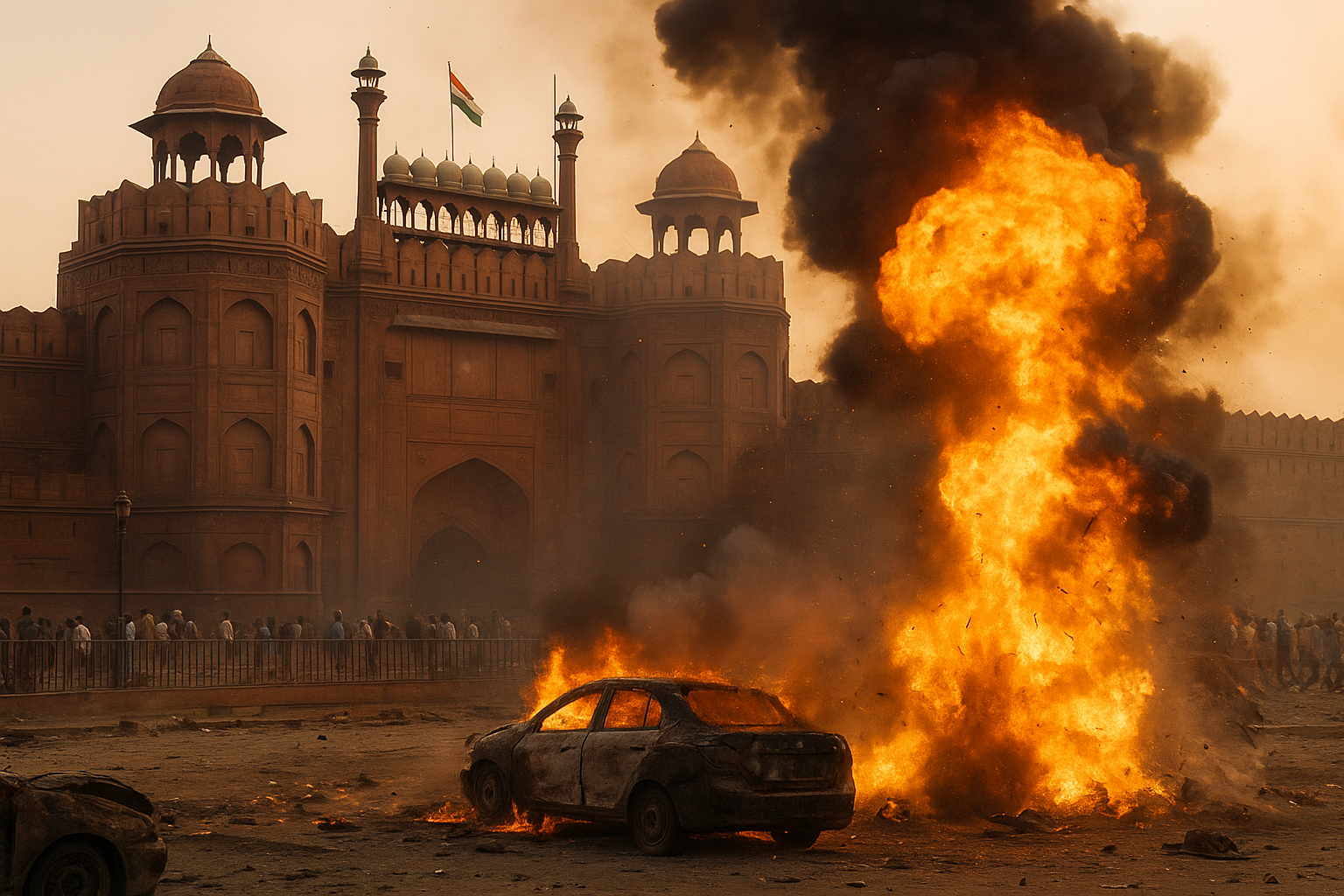By Staff Correspondent
New Delhi | India woke up to a new and deeply unsettling reality after a powerful car explosion tore through the vicinity of Delhi’s Red Fort on the evening of November 10, 2025, killing 13 people and injuring at least 24 others. The blast, which ripped apart several vehicles and shook nearby heritage buildings, has been classified as a terrorist act under the Unlawful Activities (Prevention) Act (UAPA) and the Explosive Substances Act.
For a city long accustomed to tight security, the attack has revived painful memories of the 2000 Lashkar-e-Taiba assault on the Red Fort, but investigators say this time the threat is far more insidious — one that emerges not from battle-hardened militants, but from educated, radicalized professionals.
The Attack: A Coordinated, Calculated Strike
According to Delhi Police and the National Investigation Agency (NIA), the explosion occurred at approximately 7:30 PM near the Red Fort Metro Station, a high-footfall area during evening rush hour. Eyewitnesses reported a blinding flash followed by a deafening blast that set nearby cars ablaze and shattered shopfronts across a 200-meter radius.
Preliminary forensic analysis suggests the use of ammonium nitrate fuel oil (ANFO) — a highly potent explosive mixture commonly used in mining — packed into a Hyundai i20 vehicle. Investigators noted that the car had been bought and sold seven times, with all fines and ownership records suspiciously cleared, indicating deliberate efforts to obscure its trail.
“It appears to be a suicide-style operation,” said a senior NIA officer on condition of anonymity. “The suspect inside the car likely detonated the device upon sensing imminent detection.”
Thirteen people, including pedestrians and local shopkeepers, lost their lives, while over two dozen others suffered severe burns and trauma injuries. The site was sealed for 72 hours for forensic analysis by Delhi Police, NIA, and National Security Guard (NSG) teams.
Government Response: Nationwide Alert and Political Reactions
Union Home Minister Amit Shah visited the site late Sunday night, stating that “no angle is being ruled out,” including possible cross-border coordination. Prime Minister Narendra Modi, in a statement issued from his residence, condemned the act as “a barbaric attempt to disrupt peace” and vowed “no mercy for those responsible.”
Security was immediately tightened across Delhi, NCR, and northern India, with increased border checks, metro surveillance, and random vehicle inspections. The NIA has formally taken over the probe, coordinating with multiple state Anti-Terror Squads (ATS) and central intelligence agencies.
The “White-Collar Terror” Angle: Professionals Turned Perpetrators
What makes this attack particularly alarming, investigators say, is the profile of the accused. Unlike conventional terror operatives, the suspects belong to educated, middle-class backgrounds, including doctors, engineers, and university staff — individuals capable of blending seamlessly into society while enabling high-level operations.
The module, uncovered through raids in Faridabad, Lucknow, Srinagar, Anantnag, Saharanpur, and Gujarat, has revealed a disturbing network of radicalized professionals allegedly connected to Jaish-e-Mohammed (JeM) and Ansar Ghazwat-ul-Hind (AGuH).
Key suspects include:
- Dr. Umar Mohammad (Pulwama) – Believed to be the car’s owner and suspected suicide bomber; DNA confirmation pending.
- Dr. Muzammil Ahmad Ganai – Senior doctor at Al-Falah University, Faridabad; allegedly handled explosives and recruitment.
- Dr. Adil Rather (Anantnag) – Linked to weapons recovery; previously under watch for radical activities.
- Dr. Shaheen Shahid (Lucknow) – Alleged recruiter and head of JeM’s women’s wing, Jamaat-ul-Momineen.
- Dr. Ahmed Mohiyuddin Saiyed (Gujarat) and Dr. Parvez Ansari (Lucknow) – Accused of coordinating logistics and funding.
- Several non-doctor associates, including one identified as Shakeel, aided in procuring vehicles and facilitating movement.
In total, over 10 suspects and family members have been arrested or detained.
Searches led to the recovery of 2,900 kilograms of ammonium nitrate, timers, AK-47 rifles, and electronic circuits, including 360 kg of explosives seized from Al-Falah University’s chemical labs. Investigators believe the group planned multiple coordinated attacks across Delhi, Lucknow, and Ahmedabad.

Modus Operandi: Digital Radicalization and Technical Precision
Sources in the intelligence community describe this new breed of extremists as “white-collar radicals” — professionals who use their academic expertise for terror logistics.
“They aren’t traditional militants. They are trained doctors and engineers who understand systems, networks, and digital tools,” said a counter-terror expert associated with the case.
Many members of the group were reportedly radicalized online through encrypted messaging platforms and academic chat forums. Handlers operating from Pakistan and Bangladesh allegedly directed the cell, with coordination traced to Jaish-e-Mohammed founder Masood Azhar and LeT’s Hafiz Saeed, both long associated with anti-India operations.
A recent video message by Saeed, released from an undisclosed Bangladesh location, had warned of “revenge operations” against India — a clue investigators now consider significant.
A Changing Terror Landscape
Experts are calling this the dawn of a new phase in India’s fight against terror — one where radicalization thrives not in camps, but classrooms. By infiltrating professional sectors such as healthcare, academia, and technology, terror outfits can exploit legitimate credentials to bypass scrutiny.
The case has renewed debate on the need for enhanced vetting systems in medical and educational institutions, tighter monitoring of chemical supply chains, and AI-based surveillance of online radical content.
In recent years, similar cases have emerged — such as the arrest of Pune-based software engineer Zubair Hangargekar, accused of accessing Al-Qaeda’s bomb-making manuals online — highlighting the digital shift in extremist recruitment.
Geopolitical and Security Implications
The Red Fort blast also carries wider strategic implications. Security analysts believe Pakistan’s intelligence agencies may be pursuing a “Plan B” — using educated proxies to conduct deniable operations amid global pressure and economic isolation.
India has since intensified surveillance along the Indo-Bangladesh border, suspecting the presence of logistical hubs supporting such modules.
“This was not a random attack. It signals a coordinated attempt to project internal instability while masking external involvement,” said a retired RAW officer.
A Wake-Up Call
As the NIA deepens its probe, the Red Fort blast stands as a grim reminder that terrorism in India is no longer confined to conflict zones or extremist fringes. It is migrating into the mainstream, taking the form of professionals who weaponize their education for ideology.
For the families of the 13 victims, justice will take time. But for India’s intelligence and law enforcement networks, the message is immediate and urgent: the battleground has shifted — from the border to the boardroom.






